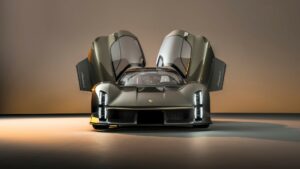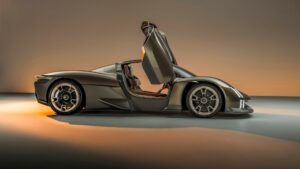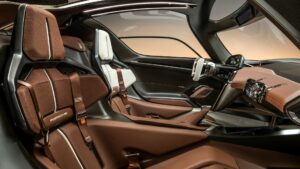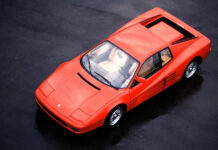This year, the iconic Porsche brand celebrates the 75th anniversary of registering the first sports car. It also celebrates this anniversary by unveiling the Mission X electric vehicle concept study.
If we look at history, on June 8, 1948, the German manufacturer received a general operating license named Porsche for the 356 “No. 1” Roadster. Thus, it was an important date for the birth of the brand producing technologically advanced sports cars.

A Model for the Technological Future
Oliver Blume, CEO of Porsche AG, said: “The Porsche Mission X is the technological beacon for the sports car of the future. It combines with the iconic sports cars of previous decades: just like the 959, the Carrera GT, and the 918 Spyder, the Mission X provides a decisive impetus for the further development of future vehicle concepts.”

This concept is a reasonably compact hypercar with a length of 4.5 m, a width of 2 m, and a height of 1.2 m. The wheelbase is 2.73 m and corresponds to the Carrera GT and 918 Spyder models. There are 20-inch tires at the front and 21-inch tires at the back. The styling elements, characteristic of the Porsche brand, are newly interpreted and depict the car. Thus, Mission X carries the highest performance and modern luxury.
Asymmetric carbon shell front seats indicate the driver orientation, along with six-point belts and an open-top steering wheel, forming a parallel to motorsport.

Technical Visions
In terms of parameters, this concept is supposed to be the best weight/power ratio (1 kg/1 hp), high downforce, and even load. Based on these technical features, if Mission X were to go into production in the future, it would become the fastest vehicle on the Nürburgring-Nordschleife circuit. The aerodynamic downforce is expected to exceed the current 911 GT3 RS.
Thanks to the 900-volt architecture, it is expected to achieve significantly better charging performance and charge twice as fast as the top-class Porsche Taycan Turbo S. The battery will find its place behind the seats in the center (the so-called E-Core arrangement), the favorable weight distribution will form the basis for excellent agility.

Supersport Predecessors
The supersport cars that appeared as milestones feature the Porsche 959 (1985), Carrera GT (2003), and the 918 Spyder (2013).
The Porsche 959 became a technological showcase in 1985. It had a six-cylinder biturbo boxer with a maximum power of 331 kW (450 hp), which in combination with an aerodynamically optimized body, allowed it to set a world record of 317 km/h among mass-produced cars of that time.
Among the super sports cars today is the Porsche Carrera GT, which has a refined design and provides an immensely engaging driving experience. A V10 engine gives the drive a maximum power of 450 kW (612 hp).

In the 916 Spyder, hybrid technology has reached a spectacular pinnacle. The first production car reached 6:57 minutes on the 20.6-kilometre Nürburgring-Nordschleife circuit in September 2013. The drive system had a maximum power of 652 kW (887 hp). Mision X may have similar ambitions – if it goes into series production.
Text: Peter Stano, photo: Porsche













